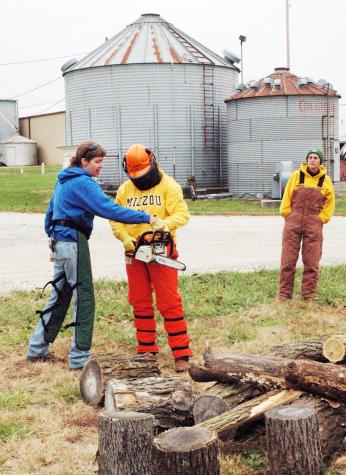COLUMBIA, Mo. – If you are looking for a holiday gift for anyone who owns a chain saw, consider chain saw safety chaps, said University of Missouri Extension horticulture specialist and woodcutter Katie Kammler.
"A $100 pair of chain saw chaps is well worth it when you compare it to the cost of a hospital emergency room visit," Kammler said.
Conventional jeans or pants do not protect against chain saw injuries.
Chain saw chaps have an outside layer of fabric that protects against minor damage. The inner layer is made with long, loose ballistic fibers designed to wrap around the chain saw's drive socket, halting the chain.
Kammler and Missouri Department of Conservation Fire Program supervisor Ben Webster recently taught a class on chain saw use and safety at the Pearls of Production: Women in Agriculture conference.
Oil and dirt degrade the effectiveness of the pants, so cleaning is required. Don't put them in a washing machine, said Webster. Use soap, water and a brush to wash them by hand.
Kammler also gives the following safety recommendations:
• Tuck drawstrings of hooded sweatshirts and pants away so they won't come into contact with the chain saw.
• Pull long hair back so it cannot become entangled in the chain saw.
• Wear lightweight leather gloves. Some chain saw gloves contain protective fabric.
• Hard hats protect your head from falling limbs. Choose one with a face guard to avoid eye injury, or use OSHA-approved safety glasses if your helmet does not have a face guard.
• Earplugs or muffs protect ears from permanent hearing loss. Noise from some gas-powered chain saws can exceed 100 decibels.
• Trim clothing free of ragged edges so it does not snag on limbs or in the saw.
• Work boots with high tops and steel toes protect your feet. Never wear athletic shoes into the woods.
• Never work alone.
• Do not work in a tree or on a ladder or other insecure support. Also, do not overreach to make a cut.
• Avoid operating a chain saw when using medication or alcohol, or when you are under mental or physical stress. The risk of injury is lower when you are alert, well-rested and healthy.
• Match your saw to your ability and comfort level.
• Maintain your saw regularly and check it before each use.
• Keep a basic first aid kit stocked with sterile, absorbent gauze pads in your vehicle.
For more information on chain saw safety, see MU Extension guides "Operating a Chain Saw Safely" (G1959) and "Selecting and Maintaining a Chain Saw" (G1954).
